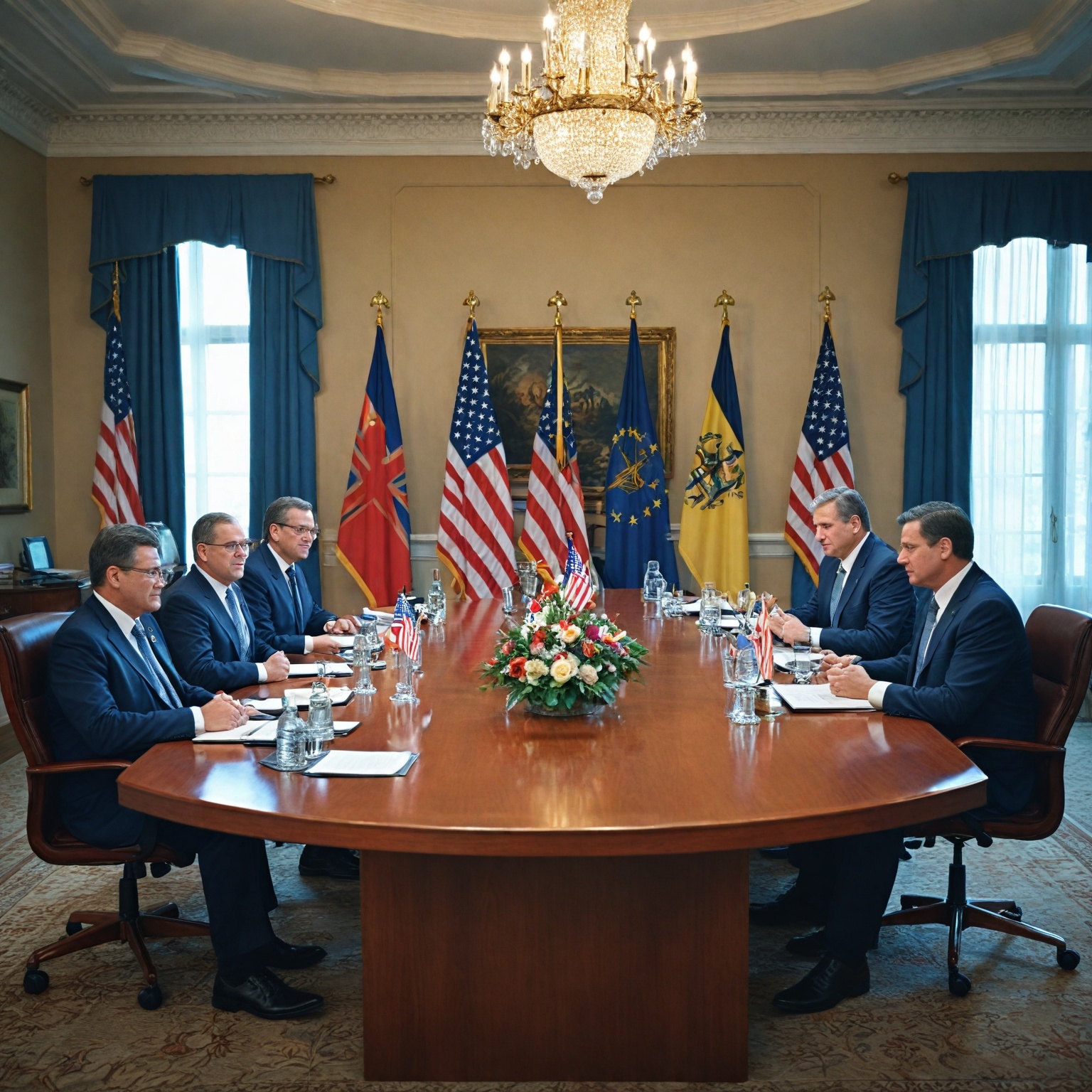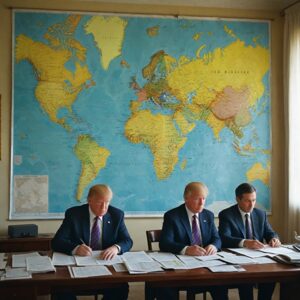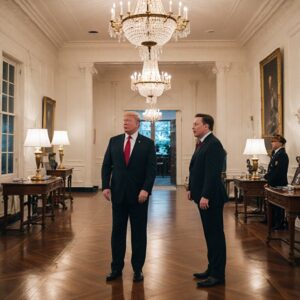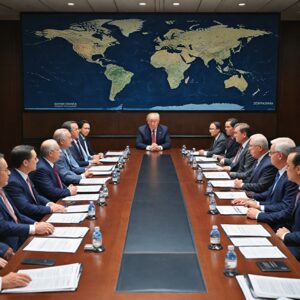Summary
The European Union (EU) and the United States (US) maintain the world’s largest bilateral commercial relationship, with trade in goods and services totaling approximately €1.6 trillion in 2023. Despite their deep economic interdependence and shared strategic interests, the two entities currently lack a dedicated free trade agreement, a notable absence given their position as each other’s largest trade and investment partners. Efforts to establish such an agreement, including the highly publicized but ultimately unsuccessful Transatlantic Trade and Investment Partnership (TTIP) negotiations from 2013 to 2016, have underscored the complexity of reconciling differing regulatory standards, political priorities, and economic policies across the Atlantic.
Recent years have seen renewed engagement through mechanisms like the EU-US Trade and Technology Council, yet negotiations remain unsettled amid persistent disagreements over regulatory cooperation, investor protections, and sector-specific sensitivities. Key issues include the US emphasis on protecting domestic manufacturing critical to national security and the EU’s insistence on maintaining high regulatory standards without undermining its economic interests. The political climate, shaped in part by domestic pressures within both the US—such as opposition from the MAGA movement—and the EU’s cautious approach to trade concessions, further complicates prospects for a comprehensive agreement.
The stakes of these negotiations extend beyond tariffs to encompass energy cooperation, supply chain security, and broader geopolitical considerations, particularly in response to challenges posed by Russia’s aggression in Ukraine and shifting global trade alliances. Economic analyses indicate that unresolved trade tensions and the imposition of tariffs could negatively impact GDP growth and sectoral employment on both sides, emphasizing the importance of regulatory and institutional mechanisms that support stable transatlantic trade relations.
Looking ahead, while both the EU and US express interest in advancing a mutually beneficial trade framework, skepticism remains about the timing and scope of any forthcoming deal. Negotiators aim to avoid disruptive trade conflicts and seek pragmatic cooperation that respects the regulatory autonomy of each party, yet unresolved political and economic differences suggest that any agreement may initially take the form of a broad framework rather than a detailed treaty. The ongoing dialogue reflects the delicate balance between economic integration and geopolitical strategy defining EU-US trade relations in the current era.
Background
The European Union (EU) and the United States (US) share the world’s most significant commercial relationship, with trade in goods and services between the two reaching €1.6 trillion in 2023. Despite the US being the EU’s largest trade and investment partner, there is currently no dedicated free trade agreement between them.
Efforts to establish such an agreement were notably marked by the Transatlantic Trade and Investment Partnership (TTIP) negotiations, launched in 2013. These talks aimed to create a comprehensive economic agreement but faced significant challenges and ultimately ended without conclusion in 2016, with formal closure declared in 2019. The failure of TTIP highlights the complexity of aligning the differing economic cultures and political frameworks of the EU and the US, despite their shared strategic interests.
Beyond trade in goods and services, energy plays a crucial role in transatlantic relations. The EU is the largest buyer of US natural gas and oil, a factor that contributes to ensuring transatlantic energy security and enables a coordinated response to geopolitical challenges such as Russia’s military aggression against Ukraine.
In recent years, political dynamics and evolving global trade priorities have influenced the pace and nature of EU-US trade negotiations. While the US administration has secured trade deals with other countries like the United Kingdom, India, Vietnam, and Japan, key sticking points remain in reaching an agreement with the EU. The EU has expressed willingness to accelerate negotiations to prevent a potential transatlantic trade war and foster a more amicable trade relationship with Washington.
The EU’s trade policy is characterized by its active engagement with countries and regional groups worldwide, aiming to secure mutually beneficial market access through agreements that cover tariffs, intellectual property, sustainable development, and human rights clauses. However, the unique challenges posed by the EU-US relationship have necessitated a cautious and adaptive approach to trade negotiations, reflecting both historical experiences and contemporary geopolitical realities.
Current Status of Trade Negotiations
Trade negotiations between the European Union (EU) and the United States (US) remain unsettled despite ongoing efforts to reach a comprehensive agreement. Although various rounds of discussions have taken place, no finalized or ratified trade deal is currently in place. This situation is reflective of a broader pattern where negotiations conclude but agreements are neither signed nor implemented immediately.
In recent years, the EU and US have sought to deepen cooperation through mechanisms such as the EU-US Trade and Technology Council (TTC), established in June 2021 to coordinate on global trade, economic, and technological issues. The latest ministerial meeting in April 2024 underscored continuing engagement but stopped short of delivering a final trade pact.
High-level diplomatic efforts, including meetings between European Trade Commissioner Maros Sefcovic and US officials, have been described as productive, yet uncertainty persists about the likelihood of a near-term agreement. US Treasury Secretary Scott Bessent expressed caution regarding the chances of striking a deal before upcoming deadlines, highlighting ongoing complexities in negotiations.
The difficulties stem partly from divergent priorities and geopolitical tensions, which complicate reciprocal trade arrangements. The US has emphasized the need to maintain a robust domestic manufacturing base for critical sectors such as bio-manufacturing and microelectronics to ensure national security, which influences its trade stance. Meanwhile, the EU is wary of concessions that might undermine its regulatory standards or economic interests, making balanced agreement challenging.
Moreover, the backdrop of shifting global alliances and tariff policies adds urgency and pressure to the talks. Both sides aim to avoid a transatlantic trade war by accelerating negotiations, but unresolved issues and mixed signals have resulted in a cautious and protracted process. Recent developments suggest that any forthcoming agreement may initially take the form of a broad framework rather than a detailed, fully operational treaty.
Trade Objectives and Priorities
The European Union’s anticipation for a trade agreement with Washington is shaped by a complex set of trade objectives and priorities that reflect both economic interests and geopolitical considerations. Central to the EU’s trade agenda is the maintenance and expansion of transatlantic economic ties, which represent one of the most significant commercial relationships globally, with EU-US trade in goods and services reaching €1.6 trillion in 2023. The EU seeks to secure access to critical supplies from the United States, including medicinal ingredients, pharmaceuticals, advanced machinery, and aerospace components, while also ensuring continued energy cooperation, as the EU is the largest buyer of U.S. natural gas and oil. This energy relationship is crucial not only for economic reasons but also for sustaining transatlantic energy security and coordinated responses to geopolitical challenges such as Russia’s military aggression against Ukraine.
From the U.S. perspective, trade agreements are viewed as instruments to create economic opportunities and support national growth. The Office of the United States Trade Representative (USTR) holds principal responsibility for administering these agreements, focusing on monitoring partners’ implementation, enforcing U.S. rights, and negotiating accords that advance presidential trade policy. The U.S. agenda reflects a drive toward comprehensive trade deals that build on existing frameworks such as the United States-Mexico-Canada Agreement (USMCA), which is seen as a bipartisan, state-of-the-art foundation for further trade negotiations. The U.S. also emphasizes innovative regulatory cooperation mechanisms, aiming to harmonize procedures with partners like the UK and, by extension, the EU, while recognizing the challenges of achieving identical regulatory standards.
Both sides acknowledge the need to avoid past pitfalls encountered in transatlantic trade negotiations. The EU has expressed concerns over mechanisms such as the investor-to-state dispute settlement (ISDS), which were perceived as disproportionately empowering multinational corporations to challenge European regulations and contributed to heightened tensions. The EU also warns against the imposition of tariffs, highlighting that such measures would be economically counterproductive, raising costs for businesses, fuelling inflation, and ultimately taxing U.S. consumers themselves. Despite these challenges, there remains a shared interest in regulatory cooperation that respects the distinctiveness of each jurisdiction’s rules but seeks to prevent unnecessary trade barriers in an integrated transatlantic economy.
Geopolitical dynamics further influence the trade objectives and priorities on both sides. The U.S. and the UK are recalibrating supply chains in response to tensions with China and broader strategic realignments, with the UK facing its own European conflicts and China’s alignment with Russia creating new complexities. The EU, meanwhile, remains cautious but engaged, seeking to avoid a transatlantic trade war and favoring negotiations that yield mutually beneficial outcomes while preparing contingency measures should talks falter. Overall, the EU’s trade priorities focus on safeguarding economic integration, securing critical imports and exports, and ensuring that regulatory and tariff policies support rather than hinder the longstanding transatlantic partnership.
Sectoral Impact and Economic Implications
The imposition of tariffs by the United States and potential retaliatory measures by the European Union have significant implications for both economies, albeit with varying degrees of impact across sectors. Macroeconomic analyses indicate that U.S. tariffs tend to weaken the American economy, while exerting moderate negative effects on the EU’s GDP overall. However, the aggregate EU impact conceals substantial heterogeneity at the sectoral and regional levels, with certain industries and Member States more exposed to trade disruptions than others.
One notable limitation of current macroeconomic models is their inability to fully capture productivity losses resulting from diminished comparative advantages and a more fragmented global trade environment. This gap suggests that the actual economic consequences of tariffs may be more severe than projected, particularly due to reduced gross trade flows and less efficient utilization of global supply chains.
Critical infrastructure sectors such as food and agriculture are particularly sensitive to trade disruptions. The United States recognizes food and agriculture as vital to national security, with the sector’s incapacity posing risks to economic and public health stability. The loss of the U.S. agricultural trade surplus further complicates this landscape, emphasizing the vulnerability of key supply chains to policy shifts.
Similarly, advanced manufacturing sectors—including bio-manufacturing, batteries, and microelectronics—are central to maintaining national security and technological leadership. U.S. defense-related industries rely heavily on a robust domestic upstream manufacturing ecosystem to avoid undue dependence on imports of essential inputs. This underscores the broader economic imperative of preserving integrated supply chains amid trade tensions.
The EU-US trade relationship is characterized by deep interdependence, with critical supplies such as medicinal ingredients, pharmaceutical products, advanced machinery, aerospace components, natural gas, and oil flowing between the two partners. In 2023, total bilateral trade in goods and services reached approximately €1.668 trillion, with services trade alone valued at around €817 billion in 2024. While the EU runs a services trade deficit with the U.S., the overall goods and services trade balance remains relatively close, with only a €48 billion difference representing about 3% of total trade. This complex trade web means that tariffs and trade barriers risk disrupting a wide array of industries that support millions of jobs on both sides of the Atlantic.
Recent tariff disputes, such as those targeting French and German aircraft parts and wines, exemplify sector-specific tensions that can have cascading effects on broader trade dynamics. Additionally, disagreements on genetically modified food policies highlight non-tariff barriers that further complicate trade negotiations.
Despite these challenges, the EU economy is projected to maintain modest GDP growth of approximately 1.1% in 2025, with employment growth expected to continue, albeit at a slowing pace. However, these forecasts have been downgraded due to increased tariffs and associated uncertainties stemming from abrupt changes in U.S. trade policies. The employment impacts of these trade tensions are uneven, with regions more exposed to U.S. tariffs facing heightened vulnerabilities.
In sum, the sectoral impacts and economic implications of the unsettled EU-US trade relationship underscore the importance of pursuing stable and comprehensive trade agreements. Such agreements would mitigate the adverse effects on critical sectors, preserve integrated supply chains, and support sustainable economic growth and job creation on both sides of the Atlantic.
Regulatory and Institutional Mechanisms
Regulatory cooperation between the European Union and the United States is centered on achieving regulatory objectives without unnecessarily impeding bilateral trade, rather than harmonizing identical rules or simply fostering dialogue between regulators. Past attempts to impose uniform regulations or rely solely on inter-regulatory discussions have yielded limited results. Instead, Washington and Brussels emphasize aligning regulations to reflect the realities of their deeply integrated transatlantic economy while preserving each party’s regulatory autonomy.
The EU’s approach to trade regulation involves active engagement with countries or regional groups to negotiate comprehensive trade agreements that provide mutual market access. These agreements are tailored to the specific partners and may include tariff reductions, intellectual property rules, sustainable development clauses, and human rights considerations. Furthermore, the EU incorporates input from the public, businesses, and non-governmental organizations throughout the negotiation process to ensure broad stakeholder representation.
In the United States, the Office of the United States Trade Representative (USTR) is principally responsible for administering trade agreements. This includes monitoring compliance by trade partners, enforcing the United States’ rights under these agreements, and leading negotiations to advance the President’s trade policy agenda. The USTR’s role is integral to maintaining the enforcement and evolution of trade commitments with the EU and other partners.
The European Commission, which negotiates trade relations on behalf of the EU, has cautioned against the imposition of tariffs, highlighting that such measures are unlawful under existing trade rules and economically counterproductive due to the integrated nature of production chains across the Atlantic. Tariffs imposed by the US would effectively tax American consumers and businesses, raise costs, and contribute to inflation. The Commission has also signaled its readiness to initiate disputes through the World Trade Organization (WTO) and has implemented an anti-coercion instrument designed to deter unilateral trade restrictions and resolve conflicts through negotiation.
Analyses using economic models demonstrate that tariffs negatively impact the US economy and, to a lesser extent, the EU’s GDP. These studies highlight the channels through which tariffs disrupt economic activity, underscoring the importance of regulatory cooperation and stable institutional mechanisms to manage trade tensions.
In the context of evolving geopolitical challenges, institutional frameworks for regulatory alignment have become increasingly significant. For example, US-UK trade negotiations prioritize building on established frameworks such as the United States-Mexico-Canada Agreement (USMCA) and exploring innovative mechanisms to harmonize selected regulatory procedures with the UK, which largely follows EU regulatory practices. This underscores a broader recognition of the need for pragmatic regulatory coordination to support resilient industrial supply chains and reduce dependence on third-party markets.
Political and Diplomatic Context
The political and diplomatic landscape surrounding the European Union’s anticipation of a trade agreement with Washington remains complex and fraught with challenges. One major source of tension has been the investor-to-state dispute settlement (ISDS) mechanism, an obscure arbitration scheme that was perceived to grant disproportionate power to multinational corporations in contesting European regulations. This issue led to considerable discord during earlier negotiations, with EU officials later acknowledging that including ISDS was a mistake and should not have been part of discussions with the United States.
The negotiating environment in Washington has also evolved significantly. Whereas prior talks, such as those under the Transatlantic Trade and Investment Partnership (TTIP) framework, involved experienced U.S. trade negotiators like Robert Lighthizer, the current administration is viewed as more erratic and less predictable. This change complicates prospects for wide-ranging diplomacy, with European negotiators recalling the previous rounds of negotiation as largely unsuccessful and cautioning against attempts to replicate that approach. Such skepticism is echoed by European trade officials who consider a return to expansive negotiations impractical and unlikely to yield productive outcomes.
Domestic political dynamics further strain transatlantic trade relations. The “Make America Great Again” (MAGA) rhetoric, often expressed by the former U.S. president, has been openly hostile toward the EU, leading analysts to predict a difficult path ahead for trade discussions. Critics highlight the slower pace of European negotiations in contrast to the U.S. approach, sometimes employing cultural metaphors to emphasize perceived European hesitancy. Moreover, while the United States has successfully advanced trade agreements with other partners such as the United Kingdom, progress with the 27-member EU bloc remains limited and hindered by unresolved disputes.
In addition to bilateral frictions, the diplomatic
Challenges and Criticisms
The anticipated trade agreement between the European Union and the United States faces significant challenges and criticisms stemming from political tensions, regulatory differences, and economic concerns. One of the major hurdles is the skepticism and opposition from political factions such as the MAGA movement in the U.S., which has openly expressed hostility toward the EU. This antagonism has been echoed by former President Donald Trump, creating a difficult environment for fruitful negotiations and prompting experts like Jacob Funk Kirkegaard to warn that the EU should “expect the worst” in ongoing trade discussions.
Negotiations have been further complicated by the legacy of previous failed attempts, notably the Transatlantic Trade and Investment Partnership (TTIP). Jean-Luc Demarty, who led the European Commission’s trade department during the TTIP talks, characterized such broad-ranging negotiations as “impossible,” emphasizing that attempting a return to similar frameworks would be a serious mistake unlikely to yield progress. Specific contentious issues include mechanisms like the investor-to-state dispute settlement (ISDS), which drew criticism for disproportionately empowering multinational corporations to challenge European regulations. EU negotiators like García Bercero have acknowledged this as a misstep in past talks.
Regulatory cooperation remains a delicate topic, as the EU and U.S. have historically struggled to harmonize their rules. The goal is not to adopt identical regulations or enforce direct dialogue between regulators—efforts that have produced little tangible outcome—but rather to agree that regulations should meet their objectives without unnecessarily impeding bilateral trade within the deeply integrated transatlantic economy.
Economic ramifications of potential trade conflicts also fuel criticism. The European Commission has warned that imposing tariffs would be both unlawful under World Trade Organization rules and economically detrimental, as such measures would effectively tax American citizens, increase business costs, and exacerbate inflation. The EU has responded by adopting anti-coercion legislation designed to deter unilateral punitive actions and resolve disputes through negotiation rather than escalation.
Trade imbalances and sector-specific vulnerabilities compound the challenges. While the U.S. once held a surplus in agricultural trade, that advantage has dissipated, complicating the agricultural dimension of trade talks. Moreover, the U.S. goods trade deficit with the EU grew by 12.9 percent in 2024, reaching $235.6 billion, highlighting the scale of economic interdependence and potential friction.
Broader economic concerns center on the adverse effects that escalating trade tensions could have on GDP growth and inflation in both regions. Intensified disputes risk triggering contagion effects that may impair financial markets and credit flows, thereby affecting economic stability across the EU and beyond. Macroeconomic models suggest that while aggregate impacts on the EU may be moderate, the effects could vary considerably among Member States and sectors, with productivity losses due to reduced trade integration potentially exacerbating negative outcomes. This uncertain economic landscape underscores the complexity and high stakes involved in securing a comprehensive and mutually beneficial trade agreement between Washington and Brussels.
Future Prospects and Scenarios
The future of a comprehensive trade agreement between the European Union (EU) and the United States remains uncertain, marked by both significant potential benefits and persistent challenges. The EU and the US currently share the world’s largest bilateral trade and investment relationship, constituting nearly 30% of global trade in goods and services and 43% of global GDP, making their economic integration unparalleled globally.
A primary anticipated course of action from the EU is to pursue negotiations aimed at reaching a mutually beneficial agreement. This approach is considered less disruptive than engaging in retaliatory tariffs, which could escalate trade tensions and harm both economies. Despite ongoing discussions, key sticking points continue to complicate prospects for an agreement, even as the US has managed to finalize deals with other countries such as the United Kingdom, India, Vietnam, and Japan.
Negotiators recognize that a comprehensive agreement would not only facilitate tariff reductions and market access but also potentially include provisions on intellectual property, sustainable development, and human rights, reflecting the EU’s broader trade policy goals. Moreover, such an agreement could address the legislative gap in digital trade objectives that the US has faced internationally following its recent retreat from commitments at the World Trade Organization (WTO).
However, geopolitical tensions add complexity to these negotiations. The US and UK, for example, are increasingly adjusting their trade strategies to reduce dependence on China amid conflicts involving Europe and alignments between China and Russia against US interests. This shifting landscape influences both the strategic priorities and the urgency with which the US and EU approach their trade discussions.
Statements from officials highlight a cautious optimism but also skepticism regarding the timeline and likelihood of concluding an agreement soon. European Trade Commissioner Maros Sefcovic described recent talks in Washington D.C. as “productive,” emphasizing a continued commitment to achieving an ambitious transatlantic trade deal. Conversely, U.S. Treasury Secretary Scott Bessent expressed uncertainty about striking a deal before forthcoming deadlines, signaling the challenges ahead.
Furthermore, broader structural issues in the global trading system present obstacles. Multilateral and plurilateral initiatives have often been blocked by trading partners, and the US’s relatively open market for imports has historically not been met with comparable reciprocal access for its exports, limiting incentives for partners to offer concessions in bilateral talks.


























